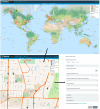BikeMaps.org: A Global Tool for Collision and Near Miss Mapping
- PMID: 25870852
- PMCID: PMC4378118
- DOI: 10.3389/fpubh.2015.00053
BikeMaps.org: A Global Tool for Collision and Near Miss Mapping
Abstract
There are many public health benefits to cycling, such as chronic disease reduction and improved air quality. Real and perceived concerns about safety are primary barriers to new ridership. Due to limited forums for official reporting of cycling incidents, lack of comprehensive data is limiting our ability to study cycling safety and conduct surveillance. Our goal is to introduce BikeMaps.org, a new website developed by the authors for crowd-source mapping of cycling collisions and near misses. BikeMaps.org is a global mapping system that allows citizens to map locations of cycling incidents and report on the nature of the event. Attributes collected are designed for spatial modeling research on predictors of safety and risk, and to aid surveillance and planning. Released in October 2014, within 2 months the website had more than 14,000 visitors and mapping in 14 countries. Collisions represent 38% of reports (134/356) and near misses 62% (222/356). In our pilot city, Victoria, Canada, citizens mapped data equivalent to about 1 year of official cycling collision reports within 2 months via BikeMaps.org. Using report completeness as an indicator, early reports indicate that data are of high quality with 50% being fully attributed and another 10% having only one missing attribute. We are advancing this technology, with the development of a mobile App, improved data visualization, real-time altering of hazard reports, and automated open-source tools for data sharing. Researchers and citizens interested in utilizing the BikeMaps.org technology can get involved by encouraging citizen mapping in their region.
Keywords: active transportation; bicycling safety; citizen science; cycling safety surveillance; near miss.
Figures



Similar articles
-
Multiuse trail intersection safety analysis: A crowdsourced data perspective.Accid Anal Prev. 2017 Jun;103:65-71. doi: 10.1016/j.aap.2017.03.024. Epub 2017 Apr 4. Accid Anal Prev. 2017. PMID: 28384490
-
What does crowdsourced data tell us about bicycling injury? A case study in a mid-sized Canadian city.Accid Anal Prev. 2020 Sep;145:105695. doi: 10.1016/j.aap.2020.105695. Epub 2020 Jul 30. Accid Anal Prev. 2020. PMID: 32739628
-
Near miss experiences of transport and recreational cyclists in New South Wales, Australia. Findings from a prospective cohort study.Accid Anal Prev. 2017 Apr;101:143-153. doi: 10.1016/j.aap.2017.01.020. Epub 2017 Feb 23. Accid Anal Prev. 2017. PMID: 28236684
-
Getting the right blood to the right patient: the contribution of near-miss event reporting and barrier analysis.Transfus Clin Biol. 2005 Nov;12(5):380-4. doi: 10.1016/j.tracli.2005.10.003. Epub 2005 Nov 28. Transfus Clin Biol. 2005. PMID: 16316757 Review.
-
[Cycling to achieve healthy and sustainable alternatives].Cien Saude Colet. 2012 Jun;17(6):1617-28. doi: 10.1590/s1413-81232012000600024. Cien Saude Colet. 2012. PMID: 22699651 Review. Portuguese.
Cited by
-
Computer vision and statistical insights into cycling near miss dynamics.Sci Rep. 2024 Sep 10;14(1):21151. doi: 10.1038/s41598-024-70733-8. Sci Rep. 2024. PMID: 39256444 Free PMC article.
-
Impacts of Bicycle Infrastructure in Mid-Sized Cities (IBIMS): protocol for a natural experiment study in three Canadian cities.BMJ Open. 2018 Jan 21;8(1):e019130. doi: 10.1136/bmjopen-2017-019130. BMJ Open. 2018. PMID: 29358440 Free PMC article.
-
Assessing the Exposome with External Measures: Commentary on the State of the Science and Research Recommendations.Annu Rev Public Health. 2017 Mar 20;38:215-239. doi: 10.1146/annurev-publhealth-082516-012802. Annu Rev Public Health. 2017. PMID: 28384083 Free PMC article. Review.
-
A Scoping Review of Citizen Science Approaches in Chronic Disease Prevention.Front Public Health. 2022 May 9;10:743348. doi: 10.3389/fpubh.2022.743348. eCollection 2022. Front Public Health. 2022. PMID: 35615030 Free PMC article.
-
Why Not Pedal for the Planet? The Role of Perceived Norms for Driver Aggression as a Deterrent to Cycling.Int J Environ Res Public Health. 2023 Mar 15;20(6):5163. doi: 10.3390/ijerph20065163. Int J Environ Res Public Health. 2023. PMID: 36982071 Free PMC article.
References
-
- Winters M, Davidson G, Kao D, Tescke K. Motivators and deterrents of bicycling: comparing influences on decisions to ride. Transportation (2011) 38:153–6810.1007/s11116-010-9284-y - DOI
-
- Pucher J, Buehler R, Seinen M. Bicycling renaissance in North America? An update and re-appraisal of cycling trends and policies. Transport Res A Pol (2011) 45(6):451–7510.1016/j.tra.2011.03.001 - DOI
LinkOut - more resources
Full Text Sources
Other Literature Sources

